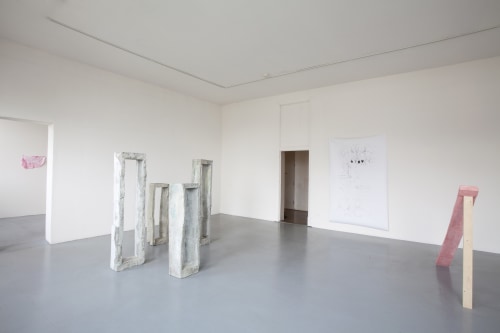
Installation view of Esther Kläs: Better Energy, (Jun 3–Sep 17, 2012) at MoMA PS1, New York, NY.
Esther Kläs: MOMA PS1
By Murtaza Vali
September 1, 2012
Esther Kläs’s mangy monoliths, two of which welcome visitors to her latest exhibition, “Better Energy,” subtly reveal her intimate process while cannily synthesizing many current trends in sculpture. Human-scale, like Rachel Harrison’santhropomorphized totems, these new works are largely abstract, their dimensions determined not by subject matter or relationship to the viewer but by the physical limits of their maker, who casts them alone in her studio. Also, like Huma Bhabha’s hardware-store ruins, Kläs’s archaic forms are often fabricated from nontraditional materials; resting on a short concrete pedestal, the putty white (M) (all works cited, 2012)—made from the unlikely combination of Structure-Lite, burlap, and Styrofoam—resembles a fragment of an ancient colossus. While its furrowed exterior at times suggests classical drapery, the uneven and textured surface, which registers but never completely reveals facture, simultaneously undermines any monumentality suggested by its form and stature.
Some of Kläs’s recent sculptures use a vibrant and nearly gaudy palette that amplifies their unsettling effect. (F), a ridged, jagged column seemingly made from several sheets of two-inch-thick Styrofoam, is actually a pigment-infused Aqua-Resin cast of such a structure; an acid-green layer under the sculpture’s luscious purple surface breaks through at its many bumps, wrinkles, seams, and edges. Nearby, hanging delicately from two clips, the ironically titled (From a distance), a piece of paper covered with rubbed-in fuchsia marks, could very well be skin flayed off another of Kläs’s new sculptures. And in hold (ex. 1), one end of a cotton-candy-pink plank—cast from Hydrocal and bowing ever so slightly in the middle—rests atop a wooden upright, creating a tall, thin ramp. On first glance the work appears to be delicately balanced—like a Richard Serra “Prop”—but an indent on the plank actually locks it in place. The relationship between such discrete sculptural elements is, as the piece’s title reiterates, more of an embrace, and thus not passively incidental but actively intimate, like Kläs’s practice as a whole.